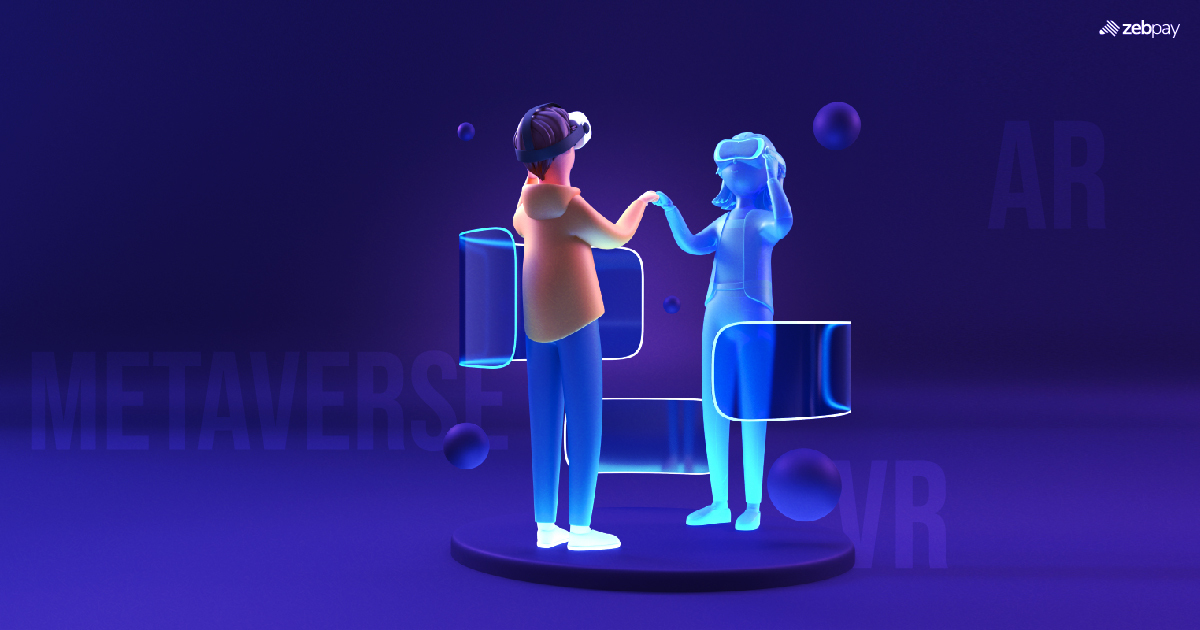The metaverse refers to a collective, internet-based 3D environment where individuals can engage with one another and computer-generated elements, such as objects and avatars. Essentially, it’s a virtual realm that relies on the Internet as its foundational network. Metaverses serve diverse purposes, including socializing, gaming, education, and training. They have the flexibility to replicate real-world settings or give rise to entirely fictional landscapes. The allure lies in the unparalleled and immersive experiences they provide, distinguishing them from other online interactions. Metaverses are in a constant state of evolution, continually expanding and presenting limitless opportunities for exploration and interaction.
This blog delves into the impact of virtual reality (VR) and augmented reality (AR) on the metaverse’s development.
Understanding Virtual Reality (VR)
Virtual reality (VR) involves computer modelling and simulation, allowing individuals to engage with a synthetic three-dimensional (3D) visual or other sensory setting. VR applications immerse users in computer-generated environments that replicate reality, facilitated by interactive devices like goggles, headsets, gloves, or body suits. In a typical VR scenario, a user dons a helmet with a stereoscopic screen, observing animated images of a simulated environment.
The sensation of “being there” (telepresence) is achieved through motion sensors that detect the user’s movements and instantly adjust the screen view accordingly. This real-time adjustment ensures that as the user moves, the perspectives within the simulated environment change convincingly, providing a seamless experience. For instance, a user can explore a simulated series of rooms, encountering varying viewpoints and perspectives directly tied to their head movements and steps. By wearing data gloves with force-feedback capabilities for touch sensation, users can even interact with and manipulate virtual objects present in the simulated environment.
Augmented Reality (AR)
Augmented reality (AR) involves seamlessly integrating digital information into the user’s real-time environment. In contrast to virtual reality (VR), which constructs entirely artificial surroundings, AR users engage with their actual surroundings while simultaneously receiving overlaid perceptual information.
AR serves the purpose of visually modifying natural environments or supplying additional information to users. Its key advantage lies in blending digital and three-dimensional (3D) elements with an individual’s perception of the genuine world. The applications of AR are diverse, ranging from aiding decision-making to providing entertainment.
Through devices like smartphones or glasses, AR delivers visual elements, sound, and other sensory data to users. This information is superimposed onto the device, creating an intertwined experience where digital content alters the user’s perception of reality. The overlaid information can either enhance the existing environment or mask parts of the natural surroundings.
Currently, consumer AR products such as Google Glass, smartphone games, and heads-up displays (HUDs) in car windshields are widely recognised. However, the technology finds application in various industries, including healthcare, petroleum, tourism, and marketing.
Read more: Metaverse vs Virtual Reality
The Convergence: VR and AR in the Metaverse
Technologies such as artificial intelligence (AI), augmented reality (AR), and virtual reality (VR) are closely associated with the concept of the metaverse. Augmented reality allows the integration of virtual objects into the real environment, while VR relies on 3D computer modelling to create immersive virtual environments. Although VR headsets or similar devices are not strictly required in the metaverse, experts predict that virtual reality technology will play a vital role in shaping this emerging digital space.
For example, the Facebook metaverse can be accessed through augmented reality glasses, virtual reality headsets, and, to a limited extent, desktop and mobile applications. Meta has revealed its development of a sophisticated virtual and augmented reality headset known as “Project Cambria.” This device, according to Meta, will support mixed reality and feature innovative sensors that allow virtual avatars to maintain eye contact and replicate the facial expressions of real individuals. Advanced technology will enhance avatar expressions, allowing them to convey human emotions and utilize body language, creating a more realistic sense of dialogue in virtual environments. According to Statista, Morgan Stanley estimates that the combined market for AR and VR is expected to reach up to $300 billion by 2024.
Social Dynamics in the Metaverse
The convergence of the metaverse and social media holds significant promise for reshaping interpersonal dynamics. In the metaverse, individuals can immerse themselves in fictional realms, engaging with others in new ways. Regardless of their physical location, people can participate in virtual events, explore digital environments, and share experiences, transcending the limitations of time and space. This facilitates seamless collaboration, creativity, and connections among individuals.
However, it is imperative to acknowledge the potential challenges associated with these immersive social interactions, including the need to safeguard privacy, prevent harassment, and ensure inclusivity in the metaverse. Deliberately designing the metaverse with these considerations is crucial to establishing a new digital space that enhances social interaction rather than hinders it.
The metaverse holds immense potential to revolutionize social interactions by dismantling geographical and physical barriers. We stand at the threshold of a new era of social connection, unlocking a myriad of possibilities for how we engage, collaborate, and build communities.
Metaverse and Education
In the education sector, the metaverse allows learners to participate in virtual classes from remote locations, providing an experience that includes elements of an actual classroom. Collaboration between educational institutions and technology companies aims to eliminate physical barriers, enhancing the immersive, engaging, and communicative aspects of virtual learning.
While e-learning offers the flexibility of education at any time and place, it cannot fully replicate the unique benefits of physical classrooms. Only a virtual 3D classroom, within the metaverse, can bridge the gap between physical and virtual learning environments. Students have the opportunity to create personalized virtual avatars, attend classes in a shared virtual 3D space with fellow students, and explore diverse avenues for experiential learning.
Effective teaching skills contribute to the appeal of learning, and the metaverse provides numerous opportunities for educators to experiment and enhance their teaching methods. Teaching professionals are keenly focused on technologies that can accelerate learning outcomes. Realistic social interactions within the metaverse contribute to the development of collaborative work environments and improved problem-solving skills. Avatars can be employed to explain concepts through roleplaying, bringing real-life scenarios to life and allowing for the creation of diverse situations within the metaverse.
Read more: How Can Metaverse Transform Learning
Entertainment and Media Evolution

Gaming was the initial form of entertainment to surface in the metaverse, with leading titles such as Roblox and Fortnite offering top-notch gaming experiences. Beyond traditional gaming elements like missions and battles, these platforms utilize blockchain technology, allowing players to trade digital assets, including non-fungible tokens (NFTs), within their created worlds.
While virtual concerts are not a new concept, recent years have seen contemporary artists like BTS, Imagine Dragons, and Post Malone hosting VR concerts. The metaverse facilitates virtual venues where multiple artists can perform simultaneously, resembling real-life concert experiences.
The global amusement park market is projected to reach USD 89.17 billion by 2025, with a compound annual growth rate (CAGR) of 9%. The growth is anticipated to stem from integrating emerging technologies like AR, VR, MR, and blockchain. Building theme parks in the virtual realm is not only cost-effective but also safer than their real-world counterparts.
Traditional theme parks have faced limitations due to their location-specific nature, hindering global user engagement. The metaverse has the potential to create intricate, non-location-specific parks, allowing visitors from around the world to explore.
Metaverses offer more immersive advertising experiences compared to traditional methods. Consumers can view products in 3D and true-to-scale within their virtual homes, an experience not possible with traditional marketing. The metaverse breaks physical boundaries.
As the metaverse is a new technology, companies can showcase innovation to consumers. In contrast to the competitive landscape of traditional marketing, the metaverse provides an opportunity for companies to stand out and develop unique advertising approaches.
Ethical and Legal Considerations
As we approach the integration of the metaverse into our daily lives, it is imperative to recognize and prepare for the potential challenges associated with this emerging frontier.
Digital Identity and Security
In the metaverse, your digital identity may hold comparable significance to your real-world identity. Consequently, safeguarding this identity and the associated personal data becomes paramount. Robust cybersecurity measures are necessary to shield users from identity theft, fraud, and various online threats.
Privacy
The wealth of data generated by our metaverse interactions, detailing behaviours, preferences, and social engagements, raises valid concerns about access and utilization. Clear and enforceable policies regarding data privacy and usage must be established to safeguard users’ rights.
Accessibility and the Digital Divide
Similar to any technology, the metaverse poses the risk of widening the digital divide if it is not universally accessible. Many may find high-speed internet and advanced hardware, such as VR headsets, beyond their reach, limiting full participation in the metaverse. This division could give rise to a new form of inequality, distinguishing those who can engage in the digital world from those who cannot.
Ethical and Legal Issues
As the boundaries between the virtual and real worlds blur, navigating ethical and legal complexities becomes more intricate. Questions arise, such as how to address virtual crime, ownership of virtual assets, and governance. Clarifying the rights of avatars and establishing measures to prevent harassment or exploitation in virtual spaces become crucial considerations.
Healthcare and Well-Being Applications
In the healthcare sector, there are numerous instances of AR/VR technology enhancing medical training for students before actual surgeries, enabling doctors to practice intricate procedures on virtual human bodies. AR-based applications, through the synchronization of multiple sensors, can assist doctors in creating simulations of patient bodies. These simulations prove valuable for working through complex scenarios or addressing the shortage of medical professionals. Additionally, it provides practitioners with opportunities to utilize available information and AR-based hardware for conducting intricate medical tests.
The significance of telemedicine has grown as more patients opt for virtual visits, and virtual reality has elevated this approach. In healthcare, VR allows doctors to conduct sensory tests on patients with motor impairments, such as muscle weakness in stroke patients. Companies like XRHealth exemplify the integration of virtual reality into telemedicine, utilizing VR headsets and engaging games to encourage patients to perform movements targeting specific areas of the body.
The benefits of AR and VR technologies extend beyond medical professionals to patients, aiding in the comprehension of medical conditions and providing details about treatments and various procedures.
Read more: How Is Metaverse Transforming Healthcare
The Future of Work and Collaboration
In the metaverse, a typical workday might involve wearing a VR headset and entering a virtual office. This digital workspace has the flexibility to be fully personalized, resembling a physical office, a serene beach, or a creative wonderland—ultimately determined by individual preferences or company choices.
Regardless of geographical location, colleagues can collaborate in real-time within these virtual environments. The metaverse offers the potential for virtual meetings that surpass traditional video calls, incorporating features like 3D presentations and interactive brainstorming sessions. Designers and engineers can collaboratively create and manipulate 3D models in real-time while team members observe and provide immediate feedback.
The metaverse can revolutionize training and professional development. Employees can participate in interactive, scenario-based training programs, elevating their skills more engagingly and practically compared to traditional online courses.
Read more: Future of the Metaverse
Conclusion
AR and VR within the metaverse have transformed the way we engage and interact in online realms, introducing new possibilities for creating more authentic virtual experiences. AR technology brings an unprecedented level of immersion, while VR opens avenues for global collaboration and interaction.
The opportunities presented by AR/VR in the metaverse enable businesses, institutions, and individuals to craft extraordinary experiences that surpass anything previously witnessed. As technology evolves, it is set to revolutionize our exploration of the metaverse and our interactions with its inhabitants.
Key factors in the metaverse’s development include the compatibility of digital objects, which is crucial for its advancement. Real-time data synchronization, a challenging and costly aspect at scale, is also imperative. Given the metaverse’s strong dependence on AR and VR technologies, the future appears promising for businesses in this sector. Those looking to develop augmented reality applications or incorporate virtual reality features have a significant opportunity to meet the expanding market demand. According to Mordor Intelligence, the global VR industry is anticipated to reach $184.66 billion by 2026. The essential role of VR and AR technologies in metaverse creation suggests a rapid expansion of the market in the years ahead.
If you found this blog to be useful, do share it with other like-minded crypto enthusiasts. Click on the button below to begin your crypto trading journey using ZebPay.







